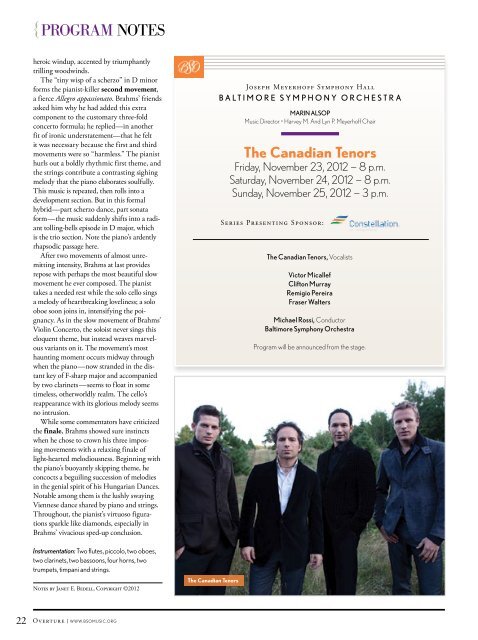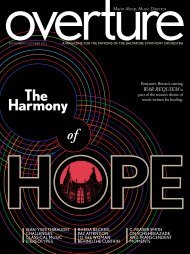November–December 2012 - Baltimore magazine
November–December 2012 - Baltimore magazine
November–December 2012 - Baltimore magazine
Create successful ePaper yourself
Turn your PDF publications into a flip-book with our unique Google optimized e-Paper software.
{ Program notes<br />
heroic windup, accented by triumphantly<br />
trilling woodwinds.<br />
The “tiny wisp of a scherzo” in D minor<br />
forms the pianist-killer second movement,<br />
a fierce Allegro appassionato. Brahms’ friends<br />
asked him why he had added this extra<br />
component to the customary three-fold<br />
concerto formula; he replied—in another<br />
fit of ironic understatement—that he felt<br />
it was necessary because the first and third<br />
movements were so “harmless.” The pianist<br />
hurls out a boldly rhythmic first theme, and<br />
the strings contribute a contrasting sighing<br />
melody that the piano elaborates soulfully.<br />
This music is repeated, then rolls into a<br />
development section. But in this formal<br />
hybrid—part scherzo dance, part sonata<br />
form—the music suddenly shifts into a radiant<br />
tolling-bells episode in D major, which<br />
is the trio section. Note the piano’s ardently<br />
rhapsodic passage here.<br />
After two movements of almost unremitting<br />
intensity, Brahms at last provides<br />
repose with perhaps the most beautiful slow<br />
movement he ever composed. The pianist<br />
takes a needed rest while the solo cello sings<br />
a melody of heartbreaking loveliness; a solo<br />
oboe soon joins in, intensifying the poignancy.<br />
As in the slow movement of Brahms’<br />
Violin Concerto, the soloist never sings this<br />
eloquent theme, but instead weaves marvelous<br />
variants on it. The movement’s most<br />
haunting moment occurs midway through<br />
when the piano—now stranded in the distant<br />
key of F-sharp major and accompanied<br />
by two clarinets—seems to float in some<br />
timeless, otherworldly realm. The cello’s<br />
reappearance with its glorious melody seems<br />
no intrusion.<br />
While some commentators have criticized<br />
the finale, Brahms showed sure instincts<br />
when he chose to crown his three imposing<br />
movements with a relaxing finale of<br />
light-hearted melodiousness. Beginning with<br />
the piano’s buoyantly skipping theme, he<br />
concocts a beguiling succession of melodies<br />
in the genial spirit of his Hungarian Dances.<br />
Notable among them is the lushly swaying<br />
Viennese dance shared by piano and strings.<br />
Throughout, the pianist’s virtuoso figurations<br />
sparkle like diamonds, especially in<br />
Brahms’ vivacious sped-up conclusion.<br />
Instrumentation: Two flutes, piccolo, two oboes,<br />
two clarinets, two bassoons, four horns, two<br />
trumpets, timpani and strings.<br />
Notes by Janet E. Bedell, Copyright ©<strong>2012</strong><br />
22 Overture | WWW.bSomuSIc.org<br />
The Canadian Tenors<br />
Joseph Meyerhoff Symphony Hall<br />
BaltiMOre SyMPhOny OrcheStra<br />
Marin alSOP<br />
music Director • Harvey m. and lyn P. meyerhoff chair<br />
The Canadian Tenors<br />
friday, november 23, <strong>2012</strong> — 8 p.m.<br />
Saturday, november 24, <strong>2012</strong> — 8 p.m.<br />
Sunday, november 25, <strong>2012</strong> — 3 p.m.<br />
Series Presenting Sponsor:<br />
the canadian tenors, Vocalists<br />
Victor Micallef<br />
clifton Murray<br />
remigio Pereira<br />
Fraser Walters<br />
Michael rossi, conductor<br />
<strong>Baltimore</strong> Symphony Orchestra<br />
Program will be announced from the stage.



